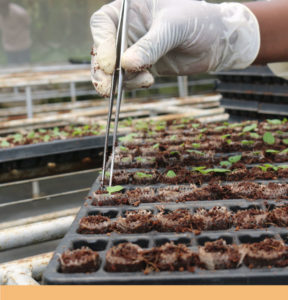Increasing farmer benefits with improved potato varieties in Peru
New and improved potato varieties are a critical first line of defense for farmers when it comes to climate change, drought, and diseases. Thirty-four potato varieties developed and released by the International Potato Center (CIP) and the National Agricultural Innovation Institution (INIA) in Peru, are helping farmers increase potato yields by 10%, and boosting livelihoods and food security. Yet not all varieties are adopted by all farmers. Understanding why is critical to the success of future breeding programs.
Improved potato varieties: The first line of defense
For the past 50 years, potato varieties have been released to farmers in Peru through CIP and INIA’s joint breeding program. Today a third of land dedicated to potato production is planted with these varieties. The program addresses farmers’ changing needs through the development and distribution of improved technologies, best agronomic practices, and more robust potato varieties bred to withstand climate change impacts like increasing temperature and disrupted rainfall patterns.
Improved varieties offer a lifeline to Peru’s farmers, particularly in the rural highlands where 90% of the country’s potato production takes place. Here poverty is high and 80% of children under 5 are undernourished.
“Potato is a critical food security crop here, supporting the livelihoods of 700,000 people, but is getting harder and harder to grow,” explains Willy Pradel, an agricultural economist at CIP based in Lima. “Farmers face weather extremes, like drought and frost, that destroy potato fields, while warmer temperatures mean that late blight can now survive at the higher altitudes where native potatoes are grown. Potato varieties just don’t have time to build resistance or adapt naturally, which is why our breeding program is so important.”
To adopt or not? The other half of the breeding story
Developing new and improved varieties is a slow, difficult, and expensive process, and for people to enjoy their benefits whether, through improved livelihoods or nutrition, the first step is to ensure that farmers adopt them.
“So far, we have released 34 varieties through the program in collaboration with INIA, and adoption rates vary. To better inform the breeding work so that it can meet farmers’ needs, we wanted to dig deeper to understand what drives farmer choices and if our varieties are making a real impact on people’s lives. So, we went to almost 1,100 potato-producing households in 11 regions, a sample that we calculated was representative of potato farmers across the country, to find out. The results were promising.”
The researchers learned that 60% of the potato area with varieties under cultivation are planted to improved varieties, of which more than half are those bred through the program. The remainder is planted to native varieties. The results also show that farmers growing CIP-bred varieties sell more potatoes and earn more money than farmers who do not and produce on average one metric ton more potatoes (10%) than other improved varieties.
The top driver influencing the adoption of new and improved varieties is market demand. “Unica produces large potatoes that are good to cook so it has a ready market, including at the big hotel chains in the towns,” says Doris Agendo Gikunda, a farmer from eastern Peru. Unica is one of the varieties released through the program.
Distances to experimental stations are also a strong influence on new variety adoption as it means that farmers in the local area are more likely to know about it. For example, the widespread adoption of the late bight resistant Amarilis variety was tested and distributed in the northern Peruvian Andes, and now occupies between 40% to 44% of potato production areas there . Disease resistance itself is also a strong factor – late blight disease alone destroys 15% of Peruvian potato production (nearly one million tons) every year.
“Different varieties bring different benefits, but they also bring risk, so we need to work hard to promote varieties, and that includes ensuring good access to quality seed,” continues Pradel. “We also need to consider that farmers with more resources may be more willing to risk a new variety than one with fewer resources.”
The results also show that gender can affect varietal choice. While men are most likely to consider markets, and how much they can produce and sell, women are likely to be more interested in traits like nutrition particularly when promotional efforts are linked to nutrition education.
“We know that potato, particularly native varieties, has untapped potential to deliver essential micronutrients like zinc, potassium, iron, and antioxidants, particularly to infants, and pregnant and lactating mothers,” explains Lupita Muñoa, CIP researcher, working on a parallel project to encourage the increased use of native potatoes in balanced diets that also include animal source foods and vegetables.
Looking ahead: From producer to consumer
While the last 50 years’ work to breed new and improved varieties has gone a long way to helping farmers solve existing problems like yield loss due to late blight disease, the work is far from complete. “We are very aware that the devastating potato purple top disease in Ecuador is moving closer to Peru. To prepare farmers for its potential arrival, or other as yet unknown threats, we need to continually investigate the genetic traits diverse potato varieties can bring to help deliver sustainable development strategies both now and in the future,” concludes Pradel.


